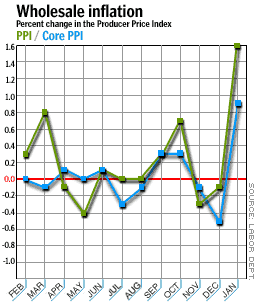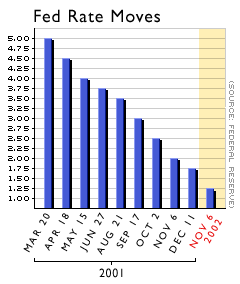NEW YORK (CNN/Money) -
The 1970s were in some ways bad years for the United States -- think Watergate, Vietnam and disco, for starters. Though some of these specific horrors thankfully won't rise again, another grim relic of the '70s very well could: stagflation.
Stagflation is a relatively new beast in economic lore, arising for the first time after an Arab oil embargo in 1973-74 nearly quadrupled prices for crude oil and retail gasoline in the United States.
The embargo pushed U.S. inflation through the roof. The growth rate in the consumer price index (CPI), the government's main measure of inflation at the retail level, nearly doubled in 1973 and nearly doubled again in 1974.

Meanwhile, the sudden shock to consumers' wallets from bloated home heating oil and gasoline prices -- not to mention the critical shopping time lost sitting in long lines at gas pumps -- helped sink the U.S. economy into a deep recession. The combination -- super-high inflation and a shrinking economy -- had never before been seen in the United States.
Could it happen again in 2003? Not likely, most economists say -- but the possibility is real.
"What is most likely, assuming a relatively quick end to war in Iraq, is a more robust economy with increased, but not problematic, inflation pressure," said Natexis Bleichroeder economist James Padinha. "After that, however, the scenario of stagflation is a very real possibility."
Inflation has seemed largely non-existent in recent years in the United States. CPI growth was a tame 1.6 percent in 2002, a far cry from the days of double-digit CPI growth in the late 1970s and early 1980s, which forced the desperate Federal Reserve to push short-term interest rates to nearly 20 percent to fight it.
In fact, in recent months some economists, seeing prices fall steadily for many goods, have worried not that inflation but deflation -- when falling prices undercut corporate profits -- was about to beset the U.S. economy after laying waste to Japan, the world's second-biggest economy, for several years.
But then the Labor Department said Thursday that its producer price index (PPI), a key measure of inflation at the producer, or wholesale, level, posted its biggest gain in 13 years in January, and suddenly, inflation was being taken more seriously.
"People have seen weakening in goods prices and have been pointing to deflation," said UBS Warburg economist Jim O'Sullivan. "This tells us we're not going there."
Much of the PPI gain came from double-digit increases in prices for oil and gasoline, price spikes that can't be avoided by most consumers and businesses. Particularly worrisome is the impact of higher oil prices on discretionary spending by consumers, whose spending fuels two-thirds of the nation's economy.
| Related stories
|

|
|
|
|
"Each one-dollar change in oil prices has a $7 billion per year impact on consumer spending," said Anthony Crescenzi, bond market strategist at Miller Tabak. "So the gain in oil prices recently, from $25 a barrel to $37, is an enormous influence on the economy -- $84 billion, in other words."
A war in Iraq would certainly push oil prices even higher. Most economists expect that spike to be temporary. But if relatively high oil prices linger after the war, it could put upward pressure on inflation and downward pressure on consumer spending.
Meanwhile, other commodity prices have been rising steadily for months, making it costlier for most companies to do business. The PPI for crude materials -- including crude oil, metal ores and cotton -- rose 7.1 percent in January before seasonal adjustments, the biggest jump since January 2001.
When production costs surge, businesses are sometimes forced to try to pass those costs along to consumers. For example, Continental Airlines Inc. (CAL: Research, Estimates) and a handful of other cash-strapped airlines tried last week to raise round-trip fares $20 to cover higher oil costs. The effort flopped, however, when Northwest Airlines Inc. (NWAC: Research, Estimates) chose not to support it.
"The sharp rise in input costs can only further pressure earnings in those sectors where there is limited pricing power, which is still most of the economy," said Joel Naroff, president and chief economist of Naroff Economic Advisors.
The falling U.S. dollar has also added inflationary pressure to the system -- if dollars are worth less, they have less purchasing power, the definition of inflation.
Meanwhile, Congress is talking about pumping hundreds of billions of dollars into the economy via tax cuts and new spending, and the Federal Reserve's target for short-term interest rates has been at a 40-year low since late 2001. These factors could flood the economy with even more dollars, further eroding their value and pushing up inflation.
On the other hand, a declining dollar helps U.S. exporters by making their goods more competitive overseas, and policy-makers are hoping the stimulus plans in the works and already low interest rates will help boost economic growth.

But if things don't quite work out that way, if the problems left over from the investment bubble of the late 1990s -- including high debt levels, low stock prices and an overhang of unused production capacity -- continue to weigh on economic growth, then all that excess money could actually make the economic situation worse.
"As growth stays sluggish and prices rise, companies are more hard-pressed to keep profits from declining. So they say, 'Sorry, we have to charge more'," said Padinha of Natexis Bleichroeder. "They can't get away with that on discretionary stuff because people will hold off, but people will be stuck paying higher prices for need-type goods and services. It becomes a circular thing."
"As an example, see any two- or three-year period in the 1970s," he added.
Almost nobody expects oil prices to quadruple as they did in the ' 70s -- oil would jump to $100 a barrel from $25 not long ago if that were the case -- or the economy to fall into the deep, dark recession.
Nevertheless, an extended period of higher prices and sluggish growth, a sort of baby stagflation, would be a headache for the economy. While the Fed won't be likely to push rates to 20 percent again to fight inflation, it might be less inclined to keep rates low or even raise rates, further weighing on the economy.
"While it's perhaps desirable for some businesses to have a little more pricing power, the overall rate of inflation could rise at a rate that's very harmful to the economy this year," said Crescenzi of Miller Tabak.

|

